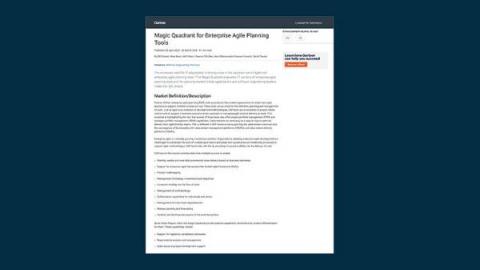Operations | Monitoring | ITSM | DevOps | Cloud
ServiceNow
ServiceNow is again a Magic Quadrant Leader in Enterprise Agile Planning Tools
I’m excited to announce ServiceNow has been recognized as a Leader in the Gartner® Magic Quadrant™ for Enterprise Agile Planning Tools for the second year in a row. This is an extremely important distinction for ServiceNow and our newly named Strategic Portfolio Management (SPM) offering. We believe this recognition reflects our expanded hybrid work management approach, financial management support, and extended integration with third-party tools.
5 steps to shift from reactive to proactive field service
Proactive field service is about being one step ahead of your customers. It requires systems that meet customer needs while minimizing their efforts. When thinking about moving from a reactive field service model to a proactive one, most people jump to the Internet of Things (IoT), servitization, and outcome-based services. But it’s important to first create an operationally efficient foundation that benefits both customers and employees. These five steps can help.
How the SEC's proposed climate disclosure rules can affect your business
Edua Dickerson, vice president of ESG and finance strategy at ServiceNow, co-authored this blog. Environmental, social, and governance (ESG) concerns are rapidly rising to the top of the corporate agenda. Not only is ESG a corporate responsibility, but it’s also a win-win for enterprises. By embracing sustainability, ethical labor practices, and effective processes and controls, organizations are laying the groundwork for increased value creation, according to McKinsey.
Field service experience could be the next business differentiator
We’ve all suffered that common irritation: “A service person will be at your house sometime between 9 am and 4 pm.” In our personal lives, that can mean frustration and inconvenience. For businesses, that broad window of uncertainty can add up to real money in lost productivity. Both scenarios can chip away at customer confidence and satisfaction. In increasingly competitive marketplaces, those agitations can even be enough to push a customer to look elsewhere.
Resources to guide you through the Now Platform San Diego release
At ServiceNow, we ushered in spring with an upgrade to the Now Platform: the San Diego release. A refresher in more ways than one, the San Diego release incorporates new features, products, and applications to power productivity and automation. In a world where innovation happens at the speed of light, ServiceNow works to empower our customers with the latest technology so that work flows smoothly. Our purpose, after all, is to make the world work better for everyone.
How tech giant Fujitsu revamped itself from inside out
Companies today face a new world. Even the largest corporate behemoths are fretting over shifts in consumer preferences, the competitive landscape, and the next shock. For many firms, COVID-19 was a wake-up call. Now, they’re taking nothing for granted and are racing to seize every advantage. Japanese giant Fujitsu is no exception.
IT Business Management becomes Strategic Portfolio Management
In today’s enterprise, technology is quickly extending beyond its birthplace in IT. Solutions that found traction with IT technologists are now helping connect everyone and everything at a company. At ServiceNow, it starts with our customers. Customers have been using ServiceNow® IT Workflows products in traditionally non-technology functions. Where these shifts became thematic, we listened and evolved our capabilities to serve those teams.
How tech helps government agency recruit for disaster response
When high temperatures, prolonged drought, and lightning strikes ignited a huge swath of Australia’s wilderness in late 2019 to mid-2020, Australians stepped up in droves to assist with the rescue and cleanup efforts. The New South Wales (NSW) Rural Fire Service (RFS), a government agency under the NSW State Public Sector, was inundated with inquiries and applications from people wanting to join the fight.
3 ways to align IT and OT asset management practices
Smart factory advancements in manufacturing mean more and more operational technology (OT) devices are connected to the network. Today, more than ever before, it’s possible to visualize and monitor OT asset health the way you monitor IT assets. It’s even possible to see the relationships and dependencies between manufacturing and OT assets. This reduces the risk that an OT-related patch or change will negatively impact the production environment.




